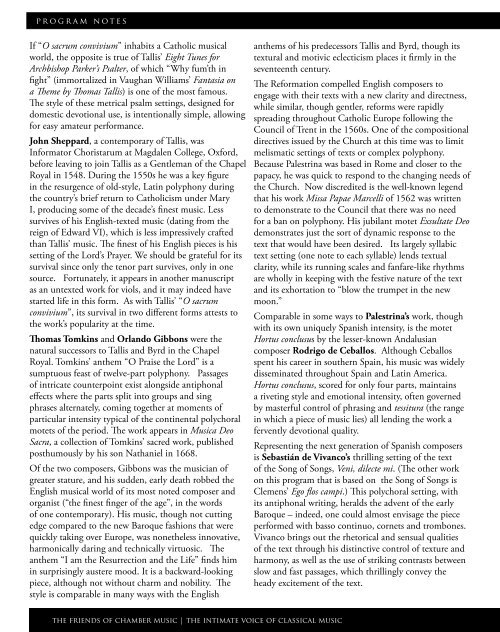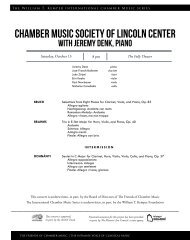Stile Antico - The Friends of Chamber Music
Stile Antico - The Friends of Chamber Music
Stile Antico - The Friends of Chamber Music
You also want an ePaper? Increase the reach of your titles
YUMPU automatically turns print PDFs into web optimized ePapers that Google loves.
program notes<br />
If “O sacrum convivium” inhabits a Catholic musical<br />
world, the opposite is true <strong>of</strong> Tallis’ Eight Tunes for<br />
Archbishop Parker’s Psalter, <strong>of</strong> which “Why fum’th in<br />
fight” (immortalized in Vaughan Williams’ Fantasia on<br />
a <strong>The</strong>me by Thomas Tallis) is one <strong>of</strong> the most famous.<br />
<strong>The</strong> style <strong>of</strong> these metrical psalm settings, designed for<br />
domestic devotional use, is intentionally simple, allowing<br />
for easy amateur performance.<br />
John Sheppard, a contemporary <strong>of</strong> Tallis, was<br />
Informator Choristarum at Magdalen College, Oxford,<br />
before leaving to join Tallis as a Gentleman <strong>of</strong> the Chapel<br />
Royal in 1548. During the 1550s he was a key figure<br />
in the resurgence <strong>of</strong> old-style, Latin polyphony during<br />
the country’s brief return to Catholicism under Mary<br />
I, producing some <strong>of</strong> the decade’s finest music. Less<br />
survives <strong>of</strong> his English-texted music (dating from the<br />
reign <strong>of</strong> Edward VI), which is less impressively crafted<br />
than Tallis’ music. <strong>The</strong> finest <strong>of</strong> his English pieces is his<br />
setting <strong>of</strong> the Lord’s Prayer. We should be grateful for its<br />
survival since only the tenor part survives, only in one<br />
source. Fortunately, it appears in another manuscript<br />
as an untexted work for viols, and it may indeed have<br />
started life in this form. As with Tallis’ “O sacrum<br />
convivium”, its survival in two different forms attests to<br />
the work’s popularity at the time.<br />
Thomas Tomkins and Orlando Gibbons were the<br />
natural successors to Tallis and Byrd in the Chapel<br />
Royal. Tomkins’ anthem “O Praise the Lord” is a<br />
sumptuous feast <strong>of</strong> twelve-part polyphony. Passages<br />
<strong>of</strong> intricate counterpoint exist alongside antiphonal<br />
effects where the parts split into groups and sing<br />
phrases alternately, coming together at moments <strong>of</strong><br />
particular intensity typical <strong>of</strong> the continental polychoral<br />
motets <strong>of</strong> the period. <strong>The</strong> work appears in <strong>Music</strong>a Deo<br />
Sacra, a collection <strong>of</strong> Tomkins’ sacred work, published<br />
posthumously by his son Nathaniel in 1668.<br />
Of the two composers, Gibbons was the musician <strong>of</strong><br />
greater stature, and his sudden, early death robbed the<br />
English musical world <strong>of</strong> its most noted composer and<br />
organist (“the finest finger <strong>of</strong> the age”, in the words<br />
<strong>of</strong> one contemporary). His music, though not cutting<br />
edge compared to the new Baroque fashions that were<br />
quickly taking over Europe, was nonetheless innovative,<br />
harmonically daring and technically virtuosic. <strong>The</strong><br />
anthem “I am the Resurrection and the Life” finds him<br />
in surprisingly austere mood. It is a backward-looking<br />
piece, although not without charm and nobility. <strong>The</strong><br />
style is comparable in many ways with the English<br />
the friends <strong>of</strong> chamber music | the intimate voice <strong>of</strong> classical music<br />
anthems <strong>of</strong> his predecessors Tallis and Byrd, though its<br />
textural and motivic eclecticism places it firmly in the<br />
seventeenth century.<br />
<strong>The</strong> Reformation compelled English composers to<br />
engage with their texts with a new clarity and directness,<br />
while similar, though gentler, reforms were rapidly<br />
spreading throughout Catholic Europe following the<br />
Council <strong>of</strong> Trent in the 1560s. One <strong>of</strong> the compositional<br />
directives issued by the Church at this time was to limit<br />
melismatic settings <strong>of</strong> texts or complex polyphony.<br />
Because Palestrina was based in Rome and closer to the<br />
papacy, he was quick to respond to the changing needs <strong>of</strong><br />
the Church. Now discredited is the well-known legend<br />
that his work Missa Papae Marcelli <strong>of</strong> 1562 was written<br />
to demonstrate to the Council that there was no need<br />
for a ban on polyphony. His jubilant motet Exsultate Deo<br />
demonstrates just the sort <strong>of</strong> dynamic response to the<br />
text that would have been desired. Its largely syllabic<br />
text setting (one note to each syllable) lends textual<br />
clarity, while its running scales and fanfare-like rhythms<br />
are wholly in keeping with the festive nature <strong>of</strong> the text<br />
and its exhortation to “blow the trumpet in the new<br />
moon.”<br />
Comparable in some ways to Palestrina’s work, though<br />
with its own uniquely Spanish intensity, is the motet<br />
Hortus conclusus by the lesser-known Andalusian<br />
composer Rodrigo de Ceballos. Although Ceballos<br />
spent his career in southern Spain, his music was widely<br />
disseminated throughout Spain and Latin America.<br />
Hortus conclusus, scored for only four parts, maintains<br />
a riveting style and emotional intensity, <strong>of</strong>ten governed<br />
by masterful control <strong>of</strong> phrasing and tessitura (the range<br />
in which a piece <strong>of</strong> music lies) all lending the work a<br />
fervently devotional quality.<br />
Representing the next generation <strong>of</strong> Spanish composers<br />
is Sebastián de Vivanco’s thrilling setting <strong>of</strong> the text<br />
<strong>of</strong> the Song <strong>of</strong> Songs, Veni, dilecte mi. (<strong>The</strong> other work<br />
on this program that is based on the Song <strong>of</strong> Songs is<br />
Clemens’ Ego flos campi.) This polychoral setting, with<br />
its antiphonal writing, heralds the advent <strong>of</strong> the early<br />
Baroque – indeed, one could almost envisage the piece<br />
performed with basso continuo, cornets and trombones.<br />
Vivanco brings out the rhetorical and sensual qualities<br />
<strong>of</strong> the text through his distinctive control <strong>of</strong> texture and<br />
harmony, as well as the use <strong>of</strong> striking contrasts between<br />
slow and fast passages, which thrillingly convey the<br />
heady excitement <strong>of</strong> the text.





